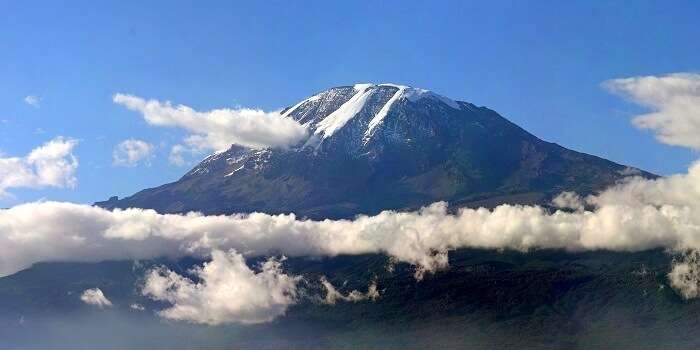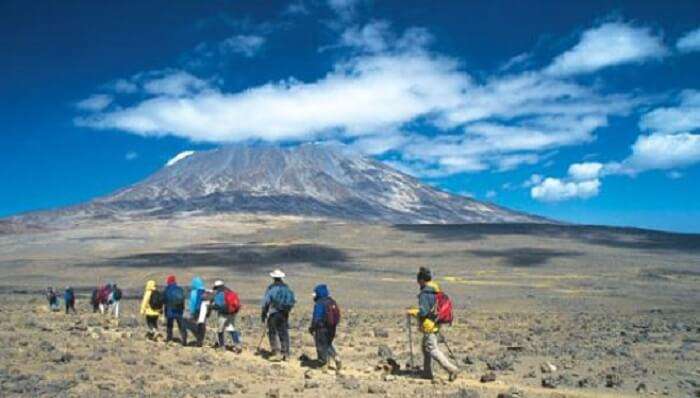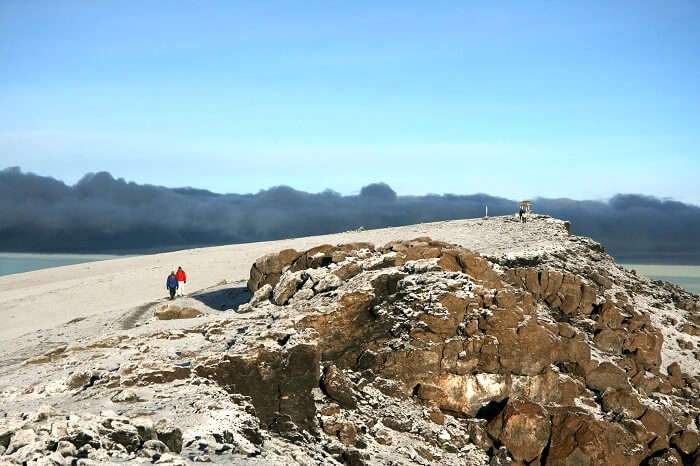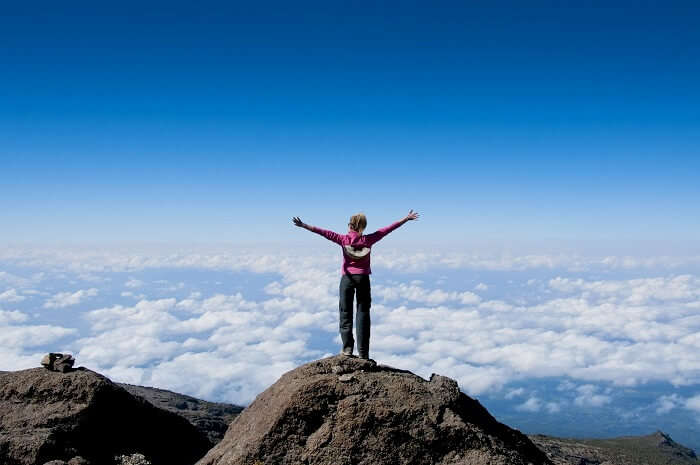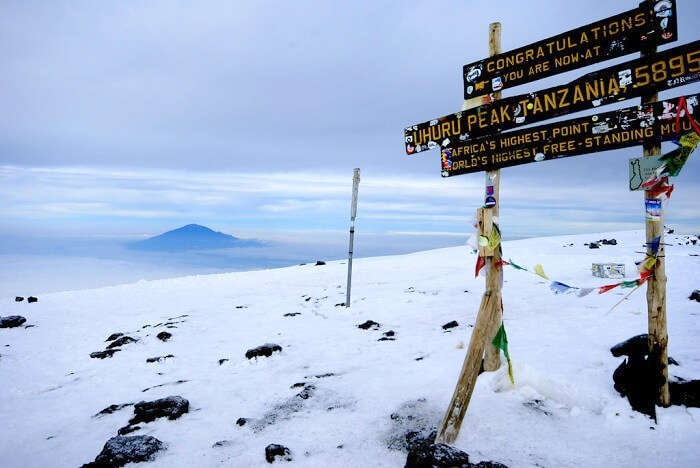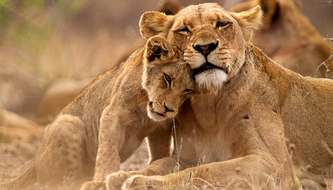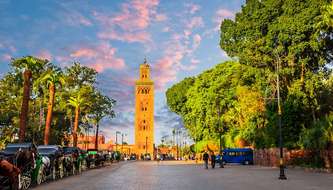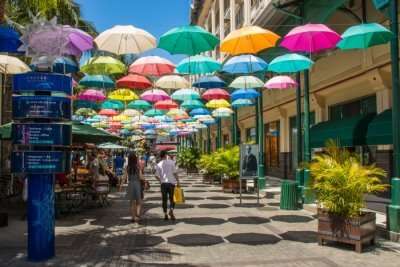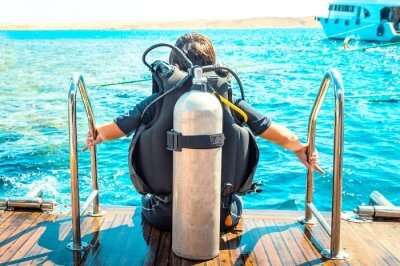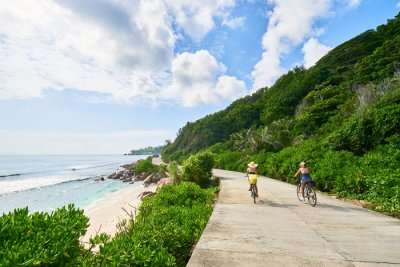Standing at a height of 5,895 meters, Mount Kilimanjaro is the highest peak of Africa and the tallest freestanding mountain on Earth. Also known as the “Roof of Africa”, this colossal mountain is a part of the seven summits of the world, and hence, attracts numerous adventure seekers from around the globe to embark on a trek to the peak of Kilimanjaro.
For those numerous adventure lovers, here’s an elaborate Kilimanjaro trek guide, that includes everything from packing essentials to cost of the trek, and from the best time to trek to the apt routes that match your level of fitness.
An Overview Of The Kilimanjaro Trek
Featuring 3 volcanic cones, namely, Kibo, Mawenzi, and Shira, Kilimanjaro is also regarded as a dormant volcano. Numerous adventure enthusiasts travel to Tanzania every year to embark on one of the most challenging treks in the world, the Kilimanjaro trek. Here are a few facts that one must know before climbing Kilimanjaro:
Location: Kilimanjaro region, Tanzania, Eastern Africa
Starting Points: Marangu, Rongai, Lemosho, Shira, Umbwe, and Machame
Ending Point: Kebo (Uhuru Peak)
Altitude: 4,900 metres from the base of the mountain, and 5,895 metres above sea level
Duration: 5 to 10 days (including ascent and descent) depending upon the route
Distance Covered (including ascent and descent): 70 kilometers (via Marangu), 62 kilometers (via Machame), 72 kilometers (via Rongai), 70 kilometers (via Lemosho), 72 kilometers (via Shira), 51 kilometers (via Umbwe)
Level of Difficulty: Even though climbing Kilimanjaro does not require any professional training but due to its altitude, Mt Kilimanjaro trek is considered to be one of the most strenuous treks in the world.
Mount Kilimanjaro Trek Temperatures: Average annual temperature at Uhuru peak varies between -70C to -290C
Available Accommodation Options: Hotels(before trek), Canvas Tents, and Trekking Huts
Suggested Read: Explore These 15 Best Places To Visit In Tanzania To Taste The Thrill Of An African Adventure!
Best Time For Kilimanjaro Trek
January to March, and June to October are considered to be the two best seasons for climbing Mount Kilimanjaro. If you have an eternal love for snow, then January to March is the best time for you to climb Mount Kilimanjaro, as this season is relatively colder, hence, the chances of witnessing snow during the summit are quite high.
June to October marks the summer season in Kilimanjaro, hence, there are relatively lesser chances of snowfall during the summit. This season is also the peak trekking season, therefore, all trekking routes are quite crowded throughout these months.
Routes For Kilimanjaro Trek
Being a mighty mountain, Kilimanjaro can be climbed through 7 different routes, namely, Machame Marangu, Rongai, Shira, Lemosho, Umbwe, and Mweka routes. Here is a brief preview of all the possible routes, along with their pros, and cons, for an easy comparison.
1. Machame Route
Also known as the ‘Whiskey Route’, due to its tough climb, Machame route is considered to be the best and the most popular route for climbing Kilimanjaro. This trail boasts of breathtaking natural bounties, and variety of flora & fauna thriving on the southern side of the mountain
Duration: 6 to 7 (including acclimatization) days
Distance Covered: 62 kilometers (approx.)
Places Of Halt: Machame Gate, Machame camp, Shira 2 camp, Lava Tower, Barranco camp, Karanga camp, Barafu camp, Uhuru Peak, and Mweka camp.
Pros:
- Relatively shorter and less expensive than Marangu route.
- Has greater success rate than Marangu route.
Cons:
- Steeper trail than Marangu.
- Extremely crowded.
Suggested Read: Honeymoon In Africa: Top 10 Romantic Getaways For The Best And Unique Experiences!
2. Marangu Route
Marangu is the oldest, and most developed route for Kilimanjaro trek. It used to be the most popular route among the climbers before the discovery of Machame route. This route is also called the ‘Coca-Cola Route’, due to its easy trekking trail.
Duration: 5 to 6 (including acclimatization) days
Distance Covered: 70 kilometers (approx.)
Places Of Halt: Mandara Hut, Horombo Hut, Mawenzi Ridge, Kibo Hut, and Marangu Gate
Pros:
- One of the easiest routes.
- Accommodations in huts rather than tents.
Cons:
- Lowest success rate as compared to other routes.
- Camping is prohibited.
3. Lemosho Route
Lemosho is one of the recently added routes to the Kilimanjaro trek, as an initiative by the Tanzanian government to reduce traffic on other routes. Lemosho is, therefore, one of the most scenic, and serene trails to Kilimanjaro, with minimum crowd even during peak seasons. This route joins the Machame and Shira routes in later days.
Duration: 6 to 8 (including acclimatization) days
Distance Covered: 70 kilometers (approx.)
Places Of Halt: Londorossi Gate, Mti Mkubwa, Shira 1 Camp, Moir Hut, Lava Tower, Barranco Camp, Karanga Camp, Barafu Camp, Uhuru Peak, Mweka Camp, and Mweka Gate.
Pros:
- Lesser crowded than other routes during early days.
- Allows time for acclimatization.
Cons:
- Since, this route requires extra days, therefore, it is a bit expensive.
- Becomes crowded during later days, when it joins Machame and Shira trail.
Suggested Read: 10 Most Splendid Zanzibar Honeymoon Resorts
4. Rongai Route
Rongai is the only route to climb Kilimanjaro from the northern side. This route is the easiest trail for Kilimanjaro trek, and is best for lesser experienced trekkers. It is also the best trail for people who wish to trek amidst remote, and tranquil surroundings.
Duration: 6 to 7 (including acclimatization) days
Distance Covered: 74 kilometers (approx.)
Places Of Halt: Rongai Gate, Rongai Cave, Second Cave, Kikelewa Cave, Mawenzi Tarn, Mawenzi Ridge, Kibo Hut, Uhuru Peak, Horombo Hut, Marangu Gate.
Pros:
- Most unchallenging, and uncrowded route for climbing Kilimanjaro.
- Since, ascent and descent are from opposite sides, the trekkers get to see both sides of the mountain.
Cons:
- More expensive than other routes as additional distance is covered.
- Not as picturesque as other routes due to its wilderness.
5. Shira Route
Beginning from the Shira Ridge, this route is not as popular among the trekkers as the other routes due to the high altitude of its starting point. Trekkers who opt for this route for their Kilimanjaro trek approach the peak from the western side of the mountain, covering the entire Shira Plateau, and descend down using the Mweka route.
Duration: 6 to 8 days
Distance Covered: 72 kilometers (approx)
Places Of Halt: Shira Gate, Simba Camp, Shira 2 Camp, Lava Tower, Barranco Camp, Karanga Camp, Barafu Camp, Uhuru Peak, Mweka Camp, and Mweka Gate.
Pros:
- Not as crowded as other routes.
- As the route starts from the rainforests, therefore, it is extremely picturesque.
Cons:
- Since this route requires additional days, therefore, it is costly.
- Due to the high altitude of the starting point, this route is quite difficult as compared to the others.
6. Umbwe Route
Approaching Kilimanjaro from the south, Umbwe route is the most difficult path to the peak. Even though it is the shortest route to Kilimanjaro, but also the steepest one. The difficulty level of this route is so high that only trained professionals dare to opt for this route.
Duration: 5 to 6 days
Distance Covered: 52 kilometers (approx.)
Places Of Halt: Umbwe Gate, Umbwe Camp, Barranco Camp, Karanga Camp, Barafu Camp, Uhuru Peak, Mweka Camp, and Mweka Gate.
Pros:
- Shortest route to Kilimanjaro
Cons:
- As this route has a direct climb, therefore, there is no time for acclimatization
- It is the steepest route to Kilimanjaro
Suggested Read: Zanzibar Honeymoon: A Romantic Journey To The Land Of Coral Reefs & Dazzling Beaches
Kilimanjaro Trek Cost
An average budget per person per day has been taken into consideration as the budget may depend on the particular trek route chosen by the trekker. It includes the cost of accommodation, meals, transport, and other miscellaneous costs such as the staff wages, camping and trekking equipments, and so on.

Flights Per Person Till Nairobi International Airport (NBO): Starts from $885 or INR 57,500 approx. for a round trip (Based on booking done 60 days prior to departure)
Accommodation Per Day (Including Kilimanjaro National Park Entrance Fees, Camp or Hut Stay): $200 or INR 13,000 per person (including Tanzanian taxes)
Meals: $10 to $20 or INR 650 or INR 1,300 per person per day
Transportation Per Person: $100 or INR 6,500 per trip on the basis of the route chosen
Miscellaneous: $80 to $150 or INR 5,200 to INR 9,750 per person per day (based on the size of the particular group)
An average budget for Kilimanjaro trek on a per day basis would cost up to $390 to $400 or INR 25,350 or 26,000 approx. per person.
PLEASE NOTE:
- The flight rates have been excluded as the rates may differ for each traveler depending upon the origin of destinations.
- Since there are no direct flights to Kenya from India, you will have to travel enroute Sharjah, or Addis Ababa airport to reach your desired destination.
- Flights like Al Arabia, Ethiopian Airlines, and Kenya Airways offer cheap connecting flights till Nairobi International Airport, from where one can take a direct flight to Kilimanjaro Airport.
- You’ll be taken in a group so make sure you do all the bookings well in advance. More the number of people, lesser will be the cost per person. Hence, choose wisely.
- Transportation cost means transferring the trekkers from the pick up point till the base of the route chosen, and dropping them back post finishing the trek. It also includes the logistical costs of the goods and equipments.
- Miscellaneous costs include local wages for the accompanying staff, trekking equipment, camping equipment, administrative costs, and so on.
- Lower limit for each type of cost has been taken into consideration for arriving at an estimated budget for the Kilimanjaro trek.
Packing Guidelines For Kilimanjaro Trek
While packing your luggage for Kilimanjaro trek, try to keep only the necessary items. Since, it is a long, and arduous trek, therefore, a lot of physical strength will be required to reach the summit. By carrying light, you will reduce the burden on your shoulders, and, hence, the extra amount of fatigue will also be eliminated.
Clothing Guide: Waterproof jackets, insulated jackets, shirts and t-shirts of moisture soaking material. Waterproof pants, hiking pants, woolen caps, woolen gloves, hiking boots, sports shoes, and warm socks.
Accessories And Equipments: Sunglasses, waterproof backpacks, sunscreens, soaps, lip balm, warm sleeping bag trekking poles, headlamp, duffel bags, and extra carry bags.
Medical: Toiletries, insect repellent, first aid kit, hand sanitizer, toilet paper, high energy snacks, electrolytes, powder, and tablets for motion sickness and altitude sickness.
Technical (optional): Mobile phones, camera, power banks, bluetooth speakers, earphones, chargers.
Documents: Air tickets, passport, visa, identity proofs, insurance, and receipts of tour package (if any)
Suggested Read: Top Safari Honeymoon Destinations, Experiences, & Resorts In The World
How To Reach Mount Kilimanjaro
By Air: Traveling by air is the easiest way to reach Kilimanjaro. The city of Kilimanjaro is equipped with an international airport which is well connected to certain foreign, and African countries.
If you cannot find direct flights to Kilimanjaro, then you can book flights to Nairobi airport, Kenya or Dar es Salaam airport, Tanzania from where you can easily get a connecting flight to Kilimanjaro.
By Train: Train services in Tanzania are quite limited, and if you choose to travel to Kilimanjaro via train, then the nearest train station will be in Arusha which is approximately 83 kilometers from Kilimanjaro. One will have to use bus, or taxi services to reach Kilimanjaro from Arusha train station to Kilimanjaro
By Road: Once you reach Tanzania, then there are abundant road transports available for Kilimanjaro. One can hire a taxi, board a bus, or Dalla Dallas (minibus).
Directions From Nairobi International Airport To Kilimanjaro Region
For those who wish to travel by road, can drive onto the Mombasa Road and C102 as shown in the map below to reach the desired destination in a time period of 7 hours by covering a distance of about 386 kms.
Suggested Read: 15 Places To Visit In Kenya That Reflect The Country’s Essence Beyond Wildlife!
Tips For Kilimanjaro Trek
- Choose the best route according to your fitness level.
- Be double sure before booking any guide, or porter.
- Train yourself before the climb, both physically and mentally.
- Carry all the essential equipments.
- Keep yourself hydrated during the trek.
- Carry essential medicines.
Adrenaline pumping high? Train hard and prepare yourself for a brave climb to the “Roof of Africa”, and quench your thirst for adventure by embarking on one of the most strenuous treks, the Kilimanjaro trek.
Disclaimer: TravelTriangle claims no credit for images featured on our blog site unless otherwise noted. All visual content is copyrighted to its respectful owners. We try to link back to original sources whenever possible. If you own rights to any of the images and do not wish them to appear on TravelTriangle, please contact us and they will be promptly removed. We believe in providing proper attribution to the original author, artist or photographer.
Please Note: Any information published by TravelTriangle in any form of content is not intended to be a substitute for any kind of medical advice, and one must not take any action before consulting a professional medical expert of their own choice.
Frequently Asked Questions About Kilimanjaro Trek
Is it possible to climb Kilimanjaro without a guide?
One can trek to Kilimanjaro only by booking a registered guide, and porters to carry necessary amenities. Therefore, it is not possible to climb Kilimanjaro without proper planning, permission, guides, and porters. What type of animal species can one encounter during their Kilimanjaro trek?
Kilimanjaro National Park is home to numerous species like leopards, spotted hyenas, giraffes, warthogs, bushbuck and blue monkeys, and water buffalos. Therefore, one can encounter numerous animal species during their trek to Kilimanjaro. Is it difficult to climb Kilimanjaro?
Standing at 5,895 meters, Kilimanjaro is the highest peak of Africa, and also a part of the seven toughest summits across the globe. Therefore, it is classified as an extreme altitude mountain trek. Therefore, everybody cannot climb Kilimanjaro without proper training, or else they will encounter various problems such as Acute Mountain Sickness (AMS) or altitude sickness.

